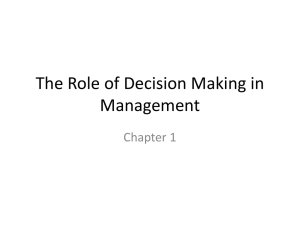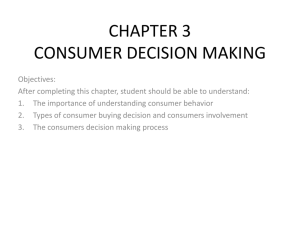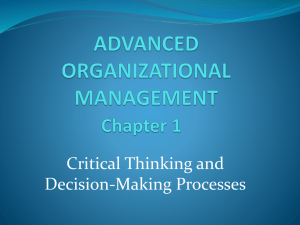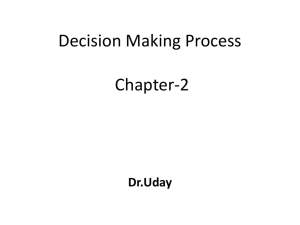Decision Making
advertisement
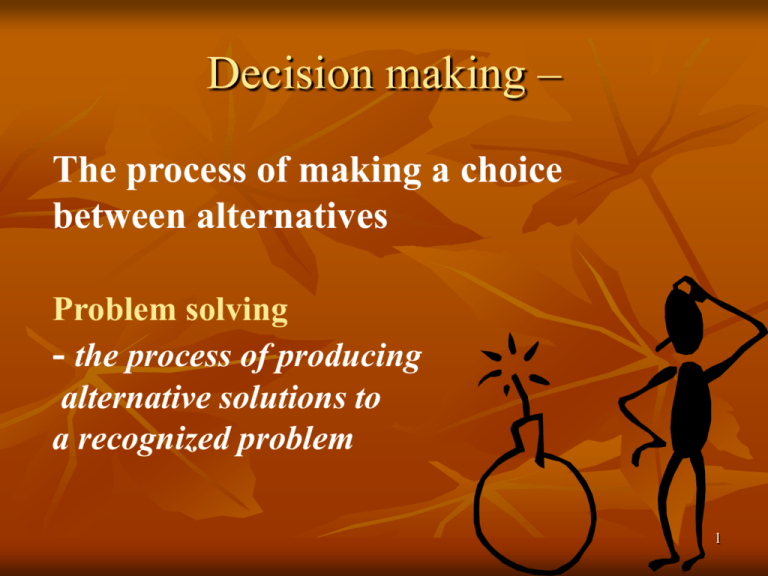
Decision making – The process of making a choice between alternatives Problem solving - the process of producing alternative solutions to a recognized problem 1 Types of decisions Programmed decisions Decisions are programmed to the extent that they are repetitive and routine and a definite procedure has been developed for handling them Nonprogrammer decisions Decisions are nonprogrammed when they are novel and unstructured. There is no established procedure for handling the problem 2 Types of decisions Programmed Decisions Nonprogrammed Decisions Type Frequent,routine, much Of problem certainty regarding causeand-effect relationships Novel,unstructured,much procedure Dependence on policies,rules,&definite procedures Necessity for creativity intuition,tolerance for ambiguity examples Periodic reorder of inventory Merit system for promotion of state employees Necessary grade-point average for good academic standing Diversification into new products & markets Reorganization of state government agencies Construction on new classroom facilities 3 uncertainty regarding causeand-effect relationships Best vs. Satisfactory decision Best decision - a chosen solution produced with full information and in adequate time to resolve a well-defined problem Satisfactory decision a partially or temporary chosen solution with partial information taken in limited time to resolve an ill-defined problem 4 Rational Decision Making Rational Model of Decision Making also called the classical model explains how managers should make decisions; it assumes managers will make logical decisions that will be optimum in furthering the organization’s best interests The Rational Model is based on unrealistic assumptions: Complete information, no uncertainty Logical, unemotional analysis, Best Decision for the organization 5 Nonrational Decision Making Five Nonrational Models are: Nonrational models of decision making explain how managers do make decisions; they assume the decision making is nearly always uncertain and risky, making it difficult for managers to make the optimum decisions Satisficing Incremental Coalitional Garbage can Intuitional 6 Nonrational Models 1. 2. 3. 4. 5. Satisficing Model managers seek alternatives until they find one that is satisfactory, not optimal Incremental Model managers take small, short-term steps to alleviate a problem Coalitional Model managers band together in groups favoring different alternatives, and the groups bargain, negotiate, and compromise on a particular problem Garbage Can Model managers virtually make random decisions Intuitive Model consists of a manager’s quickly sizing up a situation and making a decision based on his or her experience or practice 7 Some Hindrances to Perfectly Rational Decision Making Panel 7.2 Complexity Time and money constraints Different cognitive capacity, values, skills, habits, and unconscious reflexes Imperfect information Information overload Different priorities Conflicting goals 8 The Decision Making Process Establishing specific goals and objectives and measuring results Problem identification and definition Consideration of causes Development of alternative solutions Evaluation of alternative solutions Solution selection Implementation Follow-up 9 Evaluation What should you do if the solution is not working? Give it more time Change it slightly Try another alternative Start over 10 Factors influencing problem identification Perceptual problems Defining the problem in terms of solutions Identifying symptoms as problems 11 Establishing Priorities Prioritizing depends on : Urgency Relate to time. How critical is time pressure? Impact Describes the seriousness of the problem’s effects. Growth tendency Addresses future considerations. 12 Evaluation of Alternative Solutions The alternative-outcome relationship is based on 3 possible conditions: Certainty the decision maker has complete knowledge of the probability of the outcome of each alternative Uncertainty the decision maker has no knowledge of the probability of the outcome of each alternative Risk the decision maker has some probabilistic estimate of of the outcome of each alternative 13 Behavioural Influenced on Decision Making Values Propensity for risk Potential for dissonance Escalation of commitment 14 Values are guidelines in making a choice •In establishing objectives •In developing alternatives •In choosing and alternative •In implementing a decision •In evaluating and control phase (when corrective action is taken) 15 Potential for Dissonance There is often lack of consistency among individual’s various attitudes, beliefs after a decision has been made The decision is an important one psychologically or financially There are a number of foregone alternatives The forgone alternative have many favorable features 16 Methods,used to reduce dissonance: Seek information that supports the wisdom of the decision Selectively perceive information in a way that supports the decision Adopt a less favorable view of the foregone alternatives Minimize the importance of the negative aspects of the decision and exaggerate the importance of the positive aspects 17 Escalation of Commitment is the tendency to persist in an ineffective course of action when evidence reveals that the project cannot succeed 18 Individual/Group Decisions In establishing goals grouper are probably superior to individuals In identifying causes and developing alternatives efforts of group members are necessary In evaluating alternative solutions judgment if the group seems superior to that of an individual In solution selection group tends to take more risky decisions Implementation and follow-up is usually accomplished by individual managers 19 Group Decisions Advantages More information and knowledge are available More alternatives are likely to be generates More acceptance of the final decision is likely Better decisions generally emerge Disadvantages The process takes longer that individual decision making, so it is costlier Social pressures to those who disagree One person may dominate the group Groupthink may occur 20 When to use groups in decision making When it can increase quality When it can increase acceptance When it can increase development Panel 21 Techniques for Stimulating Creativity Brainstorming The Delphi Technique The Nominal Group Technique 22 Summary Decisions can be classified as programmed or nonprogrammed depending on the type of the problem there are several types of decision making process The decision-making process entails a number of steps Problems are of different importance and it’s necessary to prioritize them ( urgency, impact and growth tendency) 23 Summary The relationship between alternatives and outcomes is based on three possible conditions: certainty, uncertainty & risk The decision-making process is influenced by behavioral factors: values, propensity for risk, potential for dissonance, and escalation of commitment Research suggests that decisions made by group are superior to those made individual. However there are aspects of group decision making that have negative effects. 24
